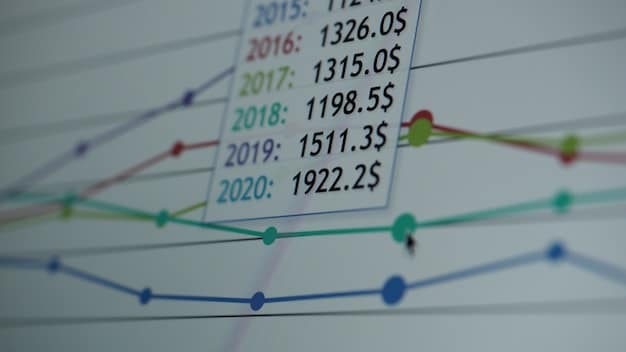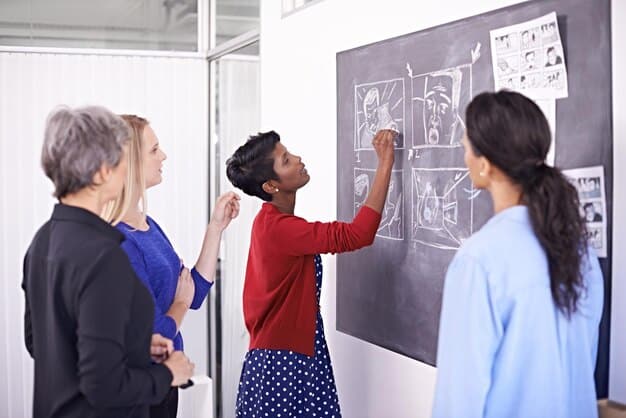Federal Reserve Holds Rates Steady: Impact on Business Investment

Breaking: The Federal Reserve has decided to hold interest rates steady, a move that could influence business investment strategies across various sectors in the US economy.
The Federal Reserve’s recent decision to hold interest rates steady has sent ripples through the business world. But what does this really mean for business investment decisions? Let’s dive into the details and explore the potential impacts of this significant economic move.
Understanding the Federal Reserve’s Decision
The Federal Reserve, often referred to as the Fed, plays a crucial role in managing the US economy. Its decisions on interest rates can significantly impact everything from consumer spending to business investments. Understanding why the Fed decided to hold rates steady is essential to grasping the broader economic context.
Factors Influencing the Fed’s Decision
Several factors likely contributed to the Federal Reserve’s decision to maintain the current interest rates. These include economic indicators, inflation rates, and global economic conditions.
Analyzing Key Economic Indicators
The Fed closely monitors various economic indicators such as GDP growth, unemployment rates, and consumer spending. Sluggish growth or rising unemployment might signal a need to keep rates low to stimulate the economy.
- GDP Growth: A slower pace of GDP growth may prompt the Fed to hold rates steady to encourage economic activity.
- Unemployment Rate: An increase in the unemployment rate can lead the Fed to maintain low rates, aiming to boost employment.
- Inflation: If inflation is under control, the Fed might choose to keep rates as is.
Ultimately, the Federal Reserve’s decision is a balancing act, weighing multiple factors to achieve its dual mandate of price stability and maximum employment.

Impact on Business Investment: An Overview
The Federal Reserve’s decision to hold interest rates steady has immediate and long-term implications for business investment. Lower interest rates generally make borrowing cheaper, which can spur investment. However, the picture is more complex when considering inflation and economic outlook.
Short-Term Effects on Investment
In the short term, businesses may feel a sense of relief. Holding rates steady provides a predictable financial environment. This stability can encourage companies to proceed with planned investments without fear of increased borrowing costs.
Long-Term Considerations for Businesses
While short-term stability is beneficial, businesses must also consider the long-term implications. Keeping rates low for an extended period could lead to inflationary pressures. This can impact supply chains, labor costs, and overall profitability.
- Inflationary Pressures: Extended low rates can lead to increased inflation, affecting business costs.
- Supply Chain Disruptions: Inflation can exacerbate supply chain issues, raising costs and delaying production.
- Labor Costs: Rising inflation may lead to demands for higher wages, increasing labor costs for businesses.
Businesses need to carefully weigh these factors to make informed investment decisions that will sustain long-term growth and profitability.
Sector-Specific Impacts of Stable Interest Rates
The impact of steady interest rates varies across different sectors of the economy. Industries like real estate and manufacturing, which are highly sensitive to interest rate changes, will experience distinct effects compared to other sectors.
Real Estate Sector
The real estate sector is particularly sensitive to interest rate changes. Holding rates steady can provide a sense of stability, encouraging both residential and commercial development.
Manufacturing Industry
For the manufacturing industry, steady interest rates can lower borrowing costs for capital investments. This can lead to increased production, expansion, and job creation.
- Capital Investments: Lower borrowing costs facilitate investments in new machinery and technology.
- Increased Production: Access to cheaper capital can boost production levels in manufacturing plants.
- Job Creation: Expanded production often leads to the creation of new job opportunities in the sector.
Understanding these sector-specific impacts can help businesses tailor their investment strategies to maximize benefits and minimize risks.
Strategies for Business Investment in the Current Climate
Given the current economic climate and the Federal Reserve’s decision, businesses need to adopt resilient investment strategies. Diversification, careful financial planning, and exploring alternative funding sources are key.

Diversification of Investments
Diversifying investments across different asset classes and sectors can mitigate risk. By spreading investments, businesses are less vulnerable to economic shocks in a single industry.
Careful Financial Planning
Thorough financial planning is essential to ensure investments align with long-term goals. This includes rigorous budgeting, forecasting, and stress-testing various economic scenarios.
- Rigorous Budgeting: Accurate budgeting is crucial for managing cash flow and allocating resources effectively.
- Economic Forecasting: Predicting future economic conditions can help businesses make informed investment decisions.
- Stress-Testing: Evaluating how investments perform under adverse conditions helps assess risk levels.
Smart financial planning can provide a buffer against uncertainty and ensure that investments are sustainable over the long term.
The Role of Government Policies and Incentives
Government policies and incentives can significantly influence business investment decisions. Tax breaks, subsidies, and regulatory frameworks can encourage or discourage investment depending on their design and implementation.
Tax Incentives for Investment
Tax incentives such as investment tax credits and accelerated depreciation can make capital investments more attractive. These policies reduce the after-tax cost of investments, encouraging businesses to expand.
Subsidies and Grants
Government subsidies and grants can provide direct financial support for specific types of investments. These programs can target strategic sectors or promote innovation.
- Direct Financial Support: Subsidies and grants provide businesses with additional capital for investments.
- Targeted Sectors: Government programs can focus on industries deemed critical for economic growth.
- Innovation Promotion: Incentives can encourage businesses to invest in new technologies and research.
Staying informed about government policies and incentives can help businesses leverage opportunities and optimize their investment strategies.
Looking Ahead: Future Economic Outlook
Looking ahead, businesses need to stay informed about the evolving economic outlook. Monitoring key indicators, understanding potential risks, and adapting to changing conditions are crucial for success.
Potential Risks to Business Investment
Several risks could impact business investment in the near future. These include rising inflation, supply chain disruptions, and geopolitical uncertainties.
Adapting to Changing Economic Conditions
Businesses must be prepared to adapt their investment strategies to changing economic conditions. This may involve adjusting investment timelines, reallocating resources, or adopting new technologies.
- Timeline Adjustments: Businesses may need to adjust their investment schedules based on economic conditions.
- Resource Reallocation: Moving resources to more promising areas can improve investment returns.
- Technology Adoption: Investing in new technologies can improve productivity and reduce costs.
Remaining agile and proactive will enable businesses to navigate challenges and capitalize on emerging opportunities, ensuring long-term success.
| Key Point | Brief Description |
|---|---|
| 📈 Rate Stability | The Fed’s hold provides a predictable financial environment for businesses. |
| ⚠️ Inflation Risks | Low rates can lead to inflationary pressures affecting supply chains and labor costs. |
| 🏢 Sector Impacts | Real estate and manufacturing are highly sensitive to these rate decisions. |
| 🌱 Diversification | Diversifying investments mitigates risk in a volatile economic climate. |
Frequently Asked Questions
▼
The Federal Reserve likely held rates to balance economic growth and inflation. They assess multiple factors, including GDP, unemployment, and consumer spending, to ensure stability.
▼
Steady rates can provide predictability for small businesses, allowing them to plan investments without the immediate fear of increased borrowing costs, promoting stability.
▼
Sectors highly sensitive to interest rates, like real estate and manufacturing, tend to benefit most as stable rates encourage investments and lower borrowing costs in the short term.
▼
Businesses should consider the risk of rising inflation, which can affect supply chains, labor costs, and overall profitability, potentially impacting long-term sustainability.
▼
Diversifying investments, careful financial planning, and staying informed about evolving economic conditions are key strategies for businesses to adapt to and navigate economic uncertainty effectively.
Conclusion
The Federal Reserve’s decision to hold interest rates steady presents both opportunities and challenges for business investment. By understanding the broader economic context, sector-specific impacts, and potential risks, businesses can make informed decisions to thrive in this evolving environment.





